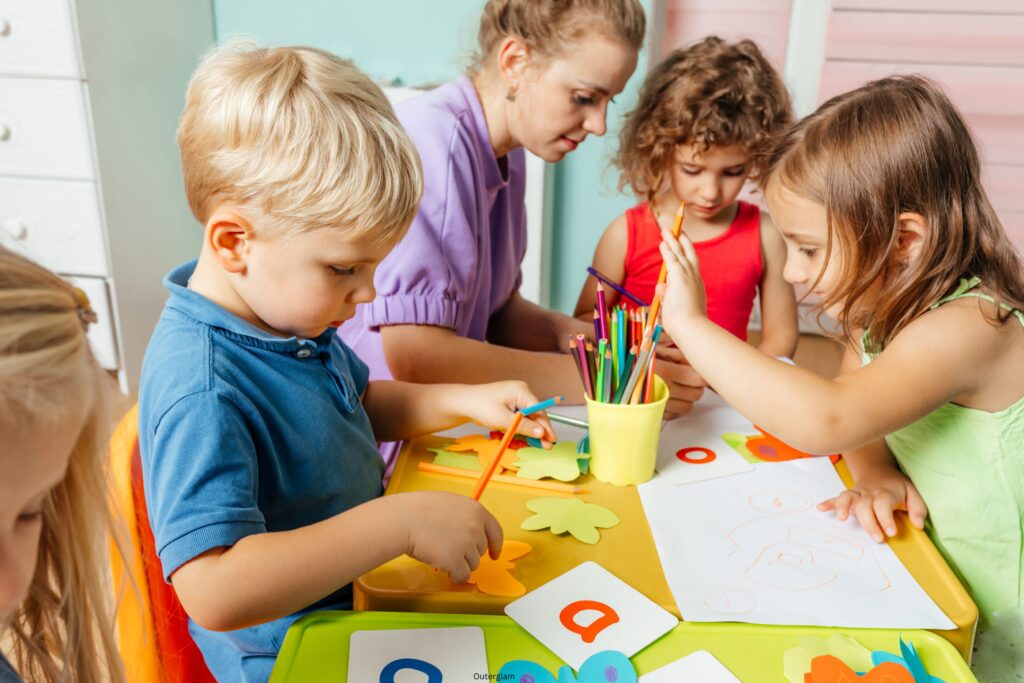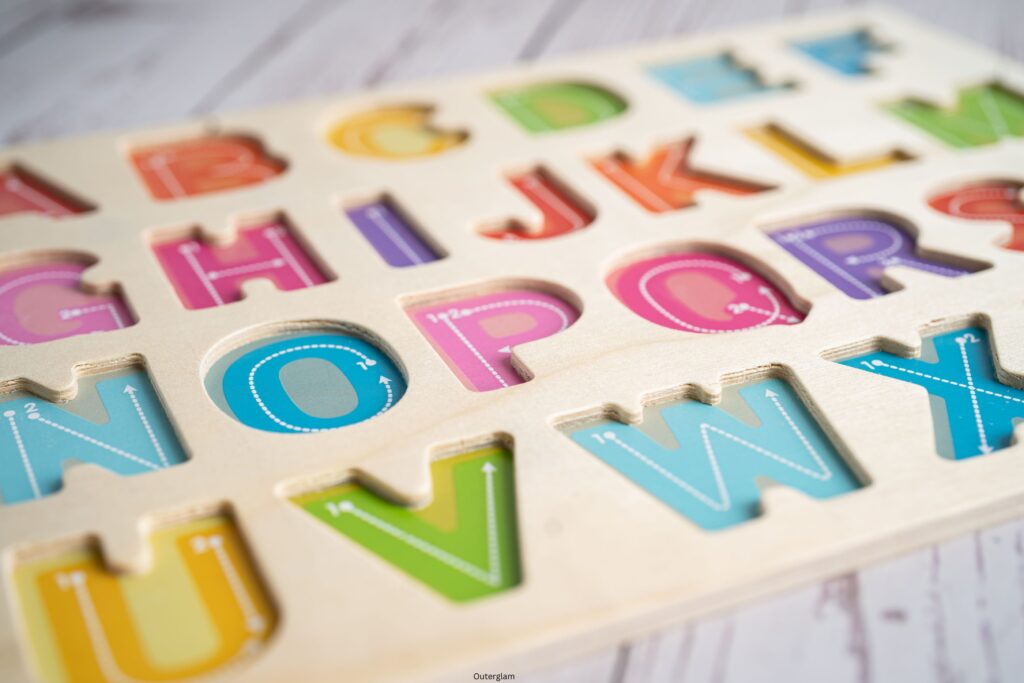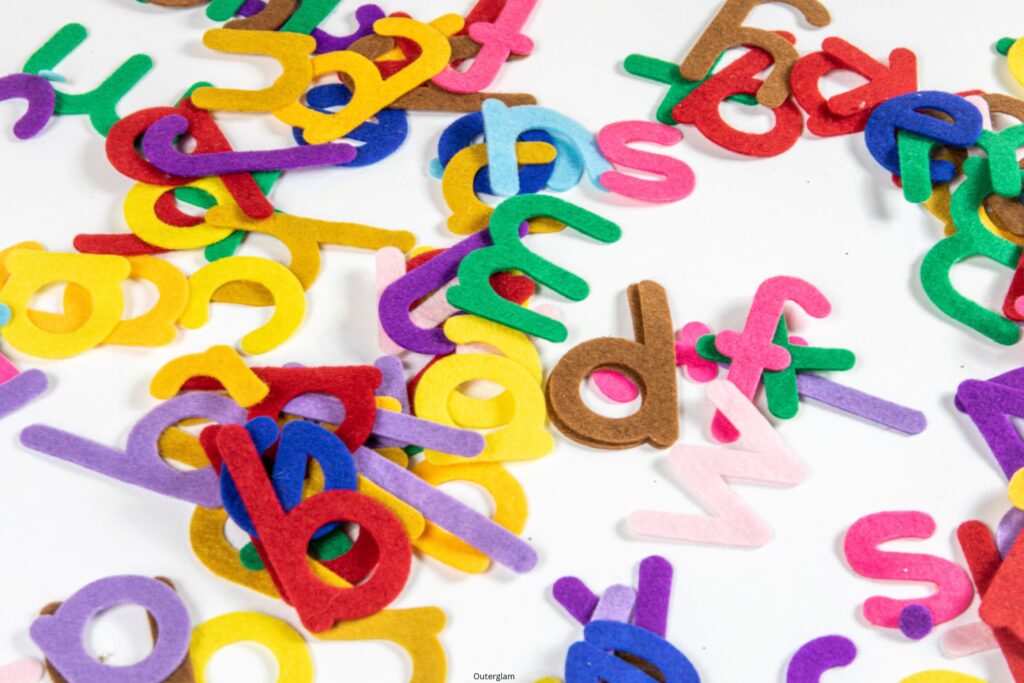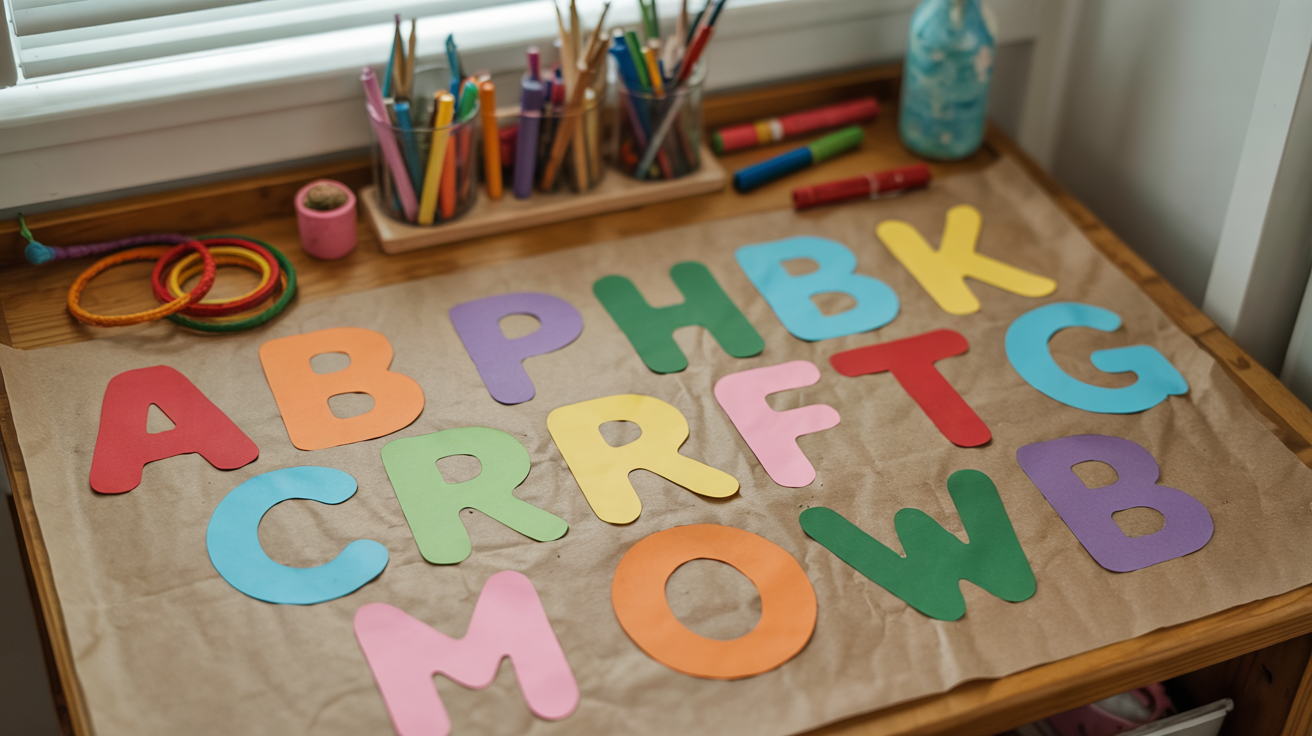Alphabet crafts offer a fantastic way for preschoolers to learn their ABCs while having fun. These hands-on activities combine creativity with education, helping little ones develop essential skills. By engaging in alphabet-themed projects, children can improve their letter recognition, fine motor skills, and early literacy foundations.
Creating a balance between enjoyment and learning is key when introducing alphabet crafts to preschoolers. The goal is to make letter learning an exciting adventure rather than a tedious task. By incorporating playful elements into educational activities, parents and teachers can keep young minds engaged and eager to explore the world of letters.
Setting up a dedicated craft space can greatly enhance the alphabet learning experience. In the following sections, we’ll share seven entertaining alphabet crafts that both teach and delight preschoolers. From sensory activities to quick projects for busy days, these ideas will help make letter learning a joyful journey for your little ones. Keep reading to discover how to turn everyday materials into alphabet masterpieces and create lasting memories with your preschoolers.
- What Are the Benefits of Alphabet Crafts for Preschoolers?
- How Can You Make Letter Learning Fun with Crafts?
- Which Alphabet Crafts Are Best for Tactile Learners?
- What Are Some Quick and Easy Alphabet Crafts for Busy Days?
- How Can You Incorporate Technology into Alphabet Crafts?
- Crafting a Love for Letters: Your Guide to Alphabet Adventures
- Frequently Asked Questions
What Are the Benefits of Alphabet Crafts for Preschoolers?

Alphabet crafts for preschoolers offer a wealth of benefits that go far beyond simply learning the ABCs. These engaging activities provide a foundation for early literacy while nurturing various developmental skills. Let’s see how these creative projects can positively impact your child’s growth and learning journey.
Enhancing letter recognition skills
One of the primary advantages of alphabet crafts is their ability to improve letter recognition. By creating letters through different mediums, children begin to associate shapes with sounds and meanings. This hands-on approach makes learning more memorable and enjoyable.
For instance, crafting a letter “A” out of pipe cleaners or forming it with playdough helps reinforce the letter’s shape in a child’s mind. As they progress, they’ll start recognizing these shapes in books, signs, and other everyday contexts.
Developing fine motor skills through hands-on activities
Alphabet crafts are excellent for honing fine motor skills, which are crucial for writing and other daily tasks. These activities require children to use their hands in various ways, strengthening the muscles needed for future writing endeavors.
Some ways alphabet crafts develop fine motor skills include:
- Cutting paper to create letter shapes
- Gluing small objects to form letters
- Tracing letters with fingers in sand or paint
- Threading beads onto pipe cleaners to form letter outlines
- Molding clay or playdough into letter shapes
Fostering creativity and self-expression
Alphabet crafts provide a canvas for children to express themselves creatively. Each project allows them to choose colors, materials, and designs, fostering a sense of ownership and pride in their creations.
This creative freedom also helps children think outside the box. They might decide to decorate their letter “B” with buttons or create a “C” out of cotton balls. These choices not only make learning fun but also help solidify letter associations in their minds.
Building confidence in early literacy
As children complete alphabet crafts, they gain confidence in their ability to recognize and create letters. This confidence is a crucial stepping stone towards reading and writing. The more comfortable they become with letters through crafts, the more likely they are to approach early reading tasks with enthusiasm.
How does this work? Well, imagine a child who has spent time crafting a colorful letter “D” out of dried pasta. When they later encounter this letter in a book, they’re more likely to recognize it and feel a sense of accomplishment. This positive association can make the entire process of learning to read more enjoyable.
Encouraging parent-child bonding during craft time
Alphabet crafts provide wonderful opportunities for parents and children to bond. Working together on these projects creates shared experiences and memories. It’s a chance for parents to offer guidance, praise efforts, and celebrate achievements.
During craft time, parents can engage in meaningful conversations about letters, words, and language. This interaction further reinforces learning and helps children develop their vocabulary and communication skills.
Moreover, these shared activities allow parents to observe their child’s progress and identify areas where they might need additional support. It’s a natural way to assess a child’s understanding without the pressure of formal evaluation.
How Can You Make Letter Learning Fun with Crafts?

Learning letters doesn’t have to be a dull experience for preschoolers. With a dash of creativity and some simple materials, you can transform alphabet lessons into exciting adventures.
Incorporating sensory elements into alphabet activities
Sensory play is a powerful tool for learning. By engaging multiple senses, children can form stronger connections with the letters they’re exploring. Try creating a sensory bin filled with rice or sand, and hide letter-shaped objects inside. As your child digs through the bin, they’ll discover letters through touch and sight.
Another idea is to use scented play dough to form letters. You could assign different scents to different letters, creating a multi-sensory experience. For example, “L” could be lemon-scented, while “V” could smell like vanilla.
Using everyday materials for letter-themed projects
Your home is full of potential craft supplies. Look around and you’ll find numerous items that can be repurposed for alphabet crafts. Here are some ideas to get you started:
- Use pasta shapes to form letters on paper
- Cut sponges into letter shapes for painting
- Create letters from popsicle sticks or toothpicks
- Form letters using buttons or small pebbles
- Shape pipe cleaners into different letters
These projects not only teach letter recognition but also promote recycling and resourcefulness.
Creating interactive alphabet games
Games make learning fun and memorable. Why not create a letter scavenger hunt around your home? Hide letter cards and have your child find them, naming each letter as they discover it. You could also play “alphabet hopscotch” by drawing letters instead of numbers on the ground and having your child hop while saying the letters.
A simple yet effective game is “letter fishing.” Cut out paper fish shapes, write letters on them, attach paperclips, and use a magnet tied to a string as a fishing rod. As your child “catches” each fish, they can practice identifying the letter.
Combining art and phonics for a holistic approach
Merging art with phonics can create a well-rounded learning experience. Try this activity: draw a large letter on paper and have your child fill it with pictures of objects that start with that letter’s sound. For “B,” they might draw a ball, a banana, and a bird.
Another idea is to create an “alphabet book” together. Each page represents a letter, decorated with drawings or cutouts of items beginning with that letter. This project combines art, letter recognition, and phonics in one engaging activity.
Tailoring crafts to different learning styles
Every child learns differently, so it’s important to offer a variety of activities that cater to different learning styles. Visual learners might prefer activities involving colorful letter cards or alphabet posters. Auditory learners could benefit from songs about letters or games that involve saying letter sounds out loud.
For kinesthetic learners, consider activities that involve movement. You could create a “letter obstacle course” where children have to complete a task related to each letter they encounter. For example, at the letter “J,” they might need to jump five times.
Tactile learners will enjoy hands-on activities like forming letters with playdough or tracing sandpaper letters. The key is to observe what engages your child most and focus on those types of activities.
Which Alphabet Crafts Are Best for Tactile Learners?

Tactile learners thrive on hands-on experiences, making alphabet crafts an ideal way for them to absorb letter knowledge. These children learn best by touching and manipulating objects, so activities that engage their sense of touch can significantly boost their letter recognition and writing skills.
Playdough letter sculpting techniques
Playdough is a versatile material that offers endless possibilities for tactile learning. Children can roll, squeeze, and mold it into various letter shapes, helping them understand the forms and lines that make up each character. To make this activity more engaging, try adding scents or glitter to the playdough. You could create a game where your child has to sculpt the letter that corresponds to a specific scent or color.
For an extra challenge, ask your child to close their eyes and guess the letter you’ve sculpted using only their sense of touch. This exercise not only reinforces letter shapes but also enhances their tactile discrimination skills.
Textured letter collages using various materials
Creating textured letter collages allows children to explore different sensations while learning the alphabet. Start by drawing large letter outlines on cardboard or thick paper. Then, provide a variety of materials with different textures for your child to glue onto the letters. Some ideas for textured materials include:
- Sandpaper
- Cotton balls
- Fabric scraps
- Dried pasta
- Buttons
- Pom-poms
As your child works on their collage, encourage them to describe the textures they’re feeling. This activity not only reinforces letter recognition but also expands their vocabulary related to touch and texture.
Sand writing trays for letter practice
Sand writing trays offer a soothing sensory experience while practicing letter formation. Fill a shallow tray with fine sand or salt, and demonstrate how to trace letters with a finger. The slight resistance of the sand provides tactile feedback, helping children understand the motions required to form each letter.
You can add variety to this activity by using different materials in the tray, such as sugar, cornmeal, or even shaving cream. Each substance will provide a unique sensory experience. For added visual appeal, place colored paper under clear trays filled with sand, allowing the letters to “appear” in different colors as your child writes.
3D letter construction with recyclables
Building three-dimensional letters from recyclable materials offers a hands-on approach to understanding letter shapes. Gather items like cardboard tubes, bottle caps, empty boxes, and plastic containers. Show your child how to assemble these materials to form letters.
This activity not only reinforces letter recognition but also develops problem-solving skills as children figure out how to construct each letter. It’s a great opportunity to discuss the characteristics of different letters – for example, how some letters have curves while others are made up of straight lines.
Finger painting alphabet activities
Finger painting is a classic tactile activity that can be easily adapted for alphabet learning. Pour some finger paint onto a tray and guide your child in forming letters with their fingers. The smooth, cool sensation of the paint provides a pleasant tactile experience while reinforcing letter shapes.
To add an extra sensory element, try making your own textured finger paints. Mix sand, salt, or even cooked oatmeal into the paint to create different textures. You could assign different textures to different letter groups, such as smooth paint for vowels and gritty paint for consonants.
Tactile alphabet crafts offer numerous benefits beyond just letter recognition. They help develop fine motor skills, enhance sensory processing, and provide a fun, engaging way to learn. By incorporating these activities into your child’s routine, you’re supporting their natural learning style and setting a strong foundation for future reading and writing skills.
What Are Some Quick and Easy Alphabet Crafts for Busy Days?
Busy days don’t mean you have to skip alphabet learning with your preschooler. There are plenty of quick and easy crafts that can fit into even the tightest schedules. These activities not only teach letter recognition but also provide a fun break for both you and your child.
5-minute letter stamping projects
Letter stamping is a swift way to engage your child with the alphabet. You don’t need fancy equipment – potato stamps work wonders. Simply cut a potato in half, carve a letter into the flat surface, dip it in paint, and stamp away on paper. This activity is not only quick but also helps develop fine motor skills.
For a less messy option, try using letter-shaped pasta or cereal as stamps. Dip them in paint and press onto paper. Your child will love seeing familiar food items transform into art supplies.
Simple alphabet scavenger hunts
Turn your home into an alphabet adventure zone with a quick scavenger hunt. Challenge your child to find items starting with specific letters. This activity requires no preparation and can be done anytime, anywhere.
To make it more exciting, set a timer for five minutes and see how many items your child can collect. You can also reverse the game by asking them to find objects that end with a particular letter sound.
Quick letter tracing activities with household items
Letter tracing doesn’t require special materials. Use what you have at home to create fun tracing activities. Here are some ideas:
- Trace letters in a tray of sugar or salt
- Use a wet paintbrush to “paint” letters on a sidewalk
- Draw letters on paper and have your child trace them with stickers or small objects like buttons
These activities are not only quick but also help reinforce letter shapes and improve handwriting skills.
Easy alphabet snacks that reinforce learning
Snack time can double as learning time with alphabet-themed treats. Shape pretzel dough into letters before baking. Or, use cookie cutters to cut sandwiches or fruits into letter shapes. For a no-prep option, arrange alphabet cereal to spell out words.
Remember, the goal is to make learning fun, not to create picture-perfect snacks. Let your child participate in the process, even if the results are a bit messy.
Fast and fun letter matching games
Letter matching games can be set up in minutes and provide quick bursts of learning. Write uppercase letters on one set of cards and lowercase on another. Mix them up and have your child match them. For added difficulty, you can include pictures of objects that start with each letter.
Another quick game: Write letters on sticky notes and stick them around a room. Call out a letter and have your child find and touch it as fast as they can. This game combines letter recognition with physical activity, perfect for burning off some energy.
These quick alphabet crafts prove that learning can happen in small pockets of time throughout the day. They’re perfect for those moments when you need a quick activity to keep your child engaged while you finish a task.
How Can You Incorporate Technology into Alphabet Crafts?
Technology can add an exciting dimension to alphabet crafts, making learning more interactive and engaging for preschoolers. By blending traditional hands-on activities with digital tools, you can create a well-rounded learning experience that caters to different learning styles.
Using educational apps to complement hands-on activities
Educational apps can serve as valuable supplements to physical alphabet crafts. Many apps offer interactive letter tracing exercises, phonics games, and alphabet-themed puzzles. These digital tools can reinforce concepts introduced through hands-on activities.
For instance, after creating a paper collage of the letter “A,” you might use an app that allows your child to trace the letter on a touchscreen. This combination of tactile and digital experiences can help solidify letter recognition and formation skills.
Creating digital alphabet books with preschoolers
Digital storytelling offers a creative way to explore the alphabet. Using simple book-making apps or even presentation software, you and your child can craft a personalized digital alphabet book. Each “page” can feature a letter along with photos or drawings of objects that start with that letter.
This project not only teaches letter recognition but also introduces basic digital literacy skills. Your child can learn how to add images, record audio, and navigate through digital pages. The resulting e-book becomes a cherished learning tool that can be revisited and shared with family members.
Exploring letter sounds with audio recording crafts
Audio recording tools open up a world of possibilities for alphabet learning. You can create sound collages for each letter, recording objects or actions that begin with that letter’s sound. For example, for the letter “B,” you might record the sound of bouncing balls, buzzing bees, or a bicycle bell.
These audio crafts help children associate letters with their corresponding sounds, a crucial skill for early reading development. Plus, the process of recording and listening to sounds can be highly entertaining for young learners.
Incorporating simple coding concepts into letter games
Believe it or not, you can introduce basic coding concepts while teaching the alphabet. Some coding apps designed for preschoolers allow children to “program” characters to move along paths shaped like letters. This activity combines letter recognition with spatial awareness and logical thinking.
Another idea is to create a simple “human robot” game. Give your child instructions to move in letter shapes, such as “Take two steps forward, turn right, take two steps back” to form an “L.” This offline activity introduces the concept of following a sequence of instructions, a fundamental principle in coding.
Virtual alphabet puzzles and interactive worksheets
Digital puzzles and worksheets can provide engaging ways to practice letter recognition and formation. Many educational websites offer interactive alphabet activities that can be completed on a computer or tablet. These might include:
- Drag-and-drop letter matching games
- Virtual letter tracing exercises
- Interactive alphabet songs with clickable letters
- Digital coloring pages featuring alphabet themes
The advantage of these digital tools is that they often provide immediate feedback, helping children learn from their mistakes in real-time.
While technology offers numerous benefits for alphabet learning, it’s important to maintain a balance with hands-on activities. Physical crafts provide sensory experiences that are crucial for young learners. The key is to use technology as a complement to, not a replacement for, traditional learning methods.
Consider setting up a “letter of the day” routine that incorporates both digital and physical activities. For example, you might start with a hands-on craft in the morning, use an educational app during quiet time, and end the day by adding a page to your digital alphabet book.
Crafting a Love for Letters: Your Guide to Alphabet Adventures
Alphabet crafts offer a world of possibilities for preschoolers to explore and learn. From hands-on activities that engage the senses to tech-enhanced games that introduce digital literacy, there’s no shortage of ways to make letter learning fun and effective. By mixing traditional crafts with modern technology, you’re providing a well-rounded educational experience that caters to different learning styles and keeps your child engaged.
As you embark on this alphabet adventure with your little one, remember that the most important ingredient is your involvement. Whether you’re sculpting letters from playdough, recording funny sounds, or creating a digital storybook together, your presence and enthusiasm will make the learning process even more meaningful. These shared experiences not only teach letters but also build lasting memories and a strong foundation for future learning. So grab some craft supplies, fire up that tablet, and get ready to explore the ABCs in ways that are both educational and entertaining.
Frequently Asked Questions
Q: What are some quick alphabet crafts for busy days?
A: Quick alphabet crafts include 5-minute letter stamping projects, simple alphabet scavenger hunts, letter tracing with household items, alphabet-themed snacks, and fast letter matching games.
Q: How can technology be incorporated into alphabet learning?
A: Technology can be used in alphabet learning through educational apps, creating digital alphabet books, audio recording crafts for letter sounds, simple coding games, and virtual alphabet puzzles.
Q: What are the benefits of alphabet crafts for preschoolers?
A: Alphabet crafts help enhance letter recognition skills, develop fine motor skills, foster creativity, build confidence in early literacy, and encourage parent-child bonding.
Q: How can you make letter learning fun with crafts?
A: You can make letter learning fun by incorporating sensory elements, using everyday materials for projects, creating interactive games, combining art and phonics, and tailoring crafts to different learning styles.
Q: What alphabet crafts are best for tactile learners?
A: Tactile learners benefit from crafts like playdough letter sculpting, textured letter collages, sand writing trays, 3D letter construction with recyclables, and finger painting alphabet activities.
Q: How can you create a digital alphabet book with preschoolers?
A: Use simple book-making apps or presentation software to create pages for each letter, adding photos, drawings, and audio recordings to make a personalized digital alphabet book.
Q: What are some ways to explore letter sounds using technology?
A: You can explore letter sounds by creating audio recordings of objects or actions that begin with each letter’s sound, making sound collages for each letter.
Q: How can coding concepts be incorporated into alphabet learning?
A: Simple coding concepts can be introduced through apps that allow children to “program” characters to move in letter shapes, or through offline “human robot” games where children follow instructions to form letters with their movements.

